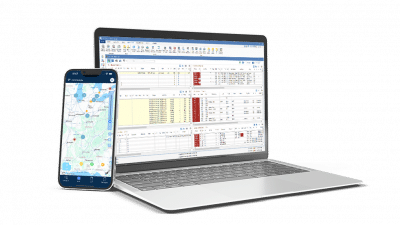In the transportation industry, a lot of factors can interfere with cash flow, and many of them are beyond your control. For example, you can’t prevent strong storms that delay deliveries. But you can use an electronic bill of lading and mobile TMS to speed up invoicing and make up for lost time.
This post explains why transitioning from a paper BOL to an electronic BOL (eBOL) should be a priority for carriers. We’ll also talk about how eBOLs and mobile TMS apps work together to improve invoicing efficiency, documentation, and cross-department visibility.
How an eBOL Works
With the right transportation management system, carriers can easily create an eBOL, because a TMS contains every data point for BOLs — customer data, load details, rates, and more.
Here’s an overview of how the process works:
- Digital Creation: You create the eBOL in your TMS. You can automate eBOL generation if you have repeat customers with consistent needs every billing cycle — like a monthly FTL delivery of a standard product between a specific warehouse and destination.
- Data Sharing: After creating the electronic bill of lading, you can share it with relevant stakeholders (shipper, carrier, consignee, driver) through digital platforms or the cloud.
- Driver Submission: Upon delivery, drivers use the TMS mobile app to capture images of any paper documentation and electronic BOL signatures. That information syncs to your main TMS, and the TMS uses artificial intelligence to audit the invoice, catalog documentation, and send invoices to the appropriate contacts.
- Integration With Billing: The eBOL data integrates directly with TMS accounting tools and tracks metrics like open invoices, short-paid invoices, and overdue accounts.
How a Mobile TMS Works for Carriers
A mobile transportation app is a “lighter” version of a TMS designed for peak efficiency. It syncs with a TMS and streamlines the flow of information between drivers, dispatchers, operations, and administrative staff.
Here’s how it helps:
Reduces Friction Between Dispatchers and Fleet Drivers
With features like document capture and real-time delivery updates, mobile TMS apps reduce the need for dispatchers to chase drivers for documents or check on their progress. Drivers don’t have to keep track of paper records or drive extra miles to turn in documentation.

Improves Relationships With Contract Drivers
For carriers using contract drivers, mobile TMS systems enable faster payment by linking eBOL submission directly to payroll systems. (Using this feature is an easy way to retain your best drivers).
Minimizes Delay-Related Complications
With a mobile TMS, dispatchers can see when drivers are running behind and proactively communicate timelines to customers. That outreach can improve customer satisfaction, which is important for retention and ongoing cash flow.
Benefits of Using eBOLs
Using electronic BOLs has several advantages for carriers:
Reduces Admin Hours
Growth-minded fleet owners often wear “all the hats” as they grow their business, working long hours to tackle a mountain of admin tasks. Automating BOL generation, submission, and integration with invoicing significantly reduces administrative task time, allowing owners to focus on growth, not busy work.
Eliminates Spreadsheets and Reduces Errors
With all load, delivery, and financial data digitized and consolidated, eBOLs remove reliance on spreadsheets and error-prone manual calculations. And when you reduce billing errors, you also reduce the number of customer billing disputes and time-consuming rebills.
Easy to Share With Other Stakeholders
You can easily share eBOLs with intermodal partners, shippers, and freight brokers, improving communication and collaboration throughout the supply chain.
Simplifies Collections
Timestamped records and real-time visibility of invoice statuses streamline the collections process. Carriers can sort invoices by days outstanding, amounts owed, or customer activity to prioritize follow-ups effectively.
Get Paid Faster (With Less Effort)
An electronic bill of lading and mobile TMS work together to reduce DOS and maintain a steady cash flow. And the TMS does most of the work for you — no more messy paperwork, incorrect calculations, or tedious data entry.
See how PCS TMS helps carriers get organized, get paid, and grow.
FAQ
Do you need an IT person to set up electronic BOLS?
Not necessarily. Many modern solutions — like PCS TMS for Carriers — eliminate the need for an in-house IT team. These platforms handle data security, backups, and routine maintenance, saving carriers a lot of money.
How do you choose a mobile TMS for carriers?
Consider factors like ease of use, integration capabilities, scalability, and cost-effectiveness. A resource like the PCS TMS Selection Guide can help you make an informed decision.



